How to Align Data with Personalization for 6x Higher Conversion

Aligning data with personalization is crucial in today's competitive landscape. By leveraging data-driven approaches, businesses can create targeted campaigns that resonate with their audience, driving higher engagement and conversion rates.
However, with the increasing emphasis on data privacy, companies must navigate complex compliance requirements while delivering personalized experiences. This delicate balance is key to unlocking the true potential of digital marketing strategies.
Key Takeaways
- Personalization can increase conversion rates by up to six times.
- Data-driven approaches are crucial for optimizing marketing performance.
- Aligning data with personalization helps in creating targeted campaigns.
- Data privacy compliance is a significant challenge for businesses.
- Balancing personalization with data privacy is key to marketing success.
The Current State of Marketing Data Fragmentation
As marketing data becomes increasingly fragmented, the need for a cohesive strategy grows. In today’s digital landscape, marketing analytics play a crucial role in understanding consumer behavior. However, the lack of integration across various data sources hinders the ability to gain data insights.
The issue of data fragmentation is not just a technical problem; it has significant financial implications. Billions of dollars are wasted due to the inability to accurately attribute marketing spend to the right channels.
The Billion-Dollar Cost of Disconnected Consumer Data
Disconnected consumer data results in inefficient marketing strategies, leading to wasted resources. According to recent studies, companies lose substantial revenue due to the lack of a unified data strategy. "The inability to connect consumer data across touchpoints costs businesses billions annually," as noted by a leading marketing expert.
Why Traditional Marketing Attribution Falls Short
Traditional marketing attribution models often fall short because they rely on incomplete or siloed data. This leads to inaccurate attribution and poor decision-making. To overcome this, businesses must adopt more sophisticated marketing analytics tools that can handle complex data sets and provide actionable data insights.
By understanding the limitations of current attribution methods, marketers can begin to explore alternative strategies that offer a more comprehensive view of their marketing efforts.
Understanding the Power of Data-Driven Marketing Strategies
In today's data-driven marketing landscape, understanding the power of unified data is crucial for driving revenue growth. By leveraging customer segmentation and audience targeting, businesses can create highly personalized marketing strategies that resonate with their target audience.
Our Marketing Data Platform addresses the gaps in traditional marketing attribution by unifying consumer identities, enhancing attribution, and ensuring GDPR/CCPA compliance. This approach enables marketers to make data-driven decisions that drive real results.
The Connection Between Unified Data and Revenue Growth
Unified data is the backbone of any successful marketing strategy. By bringing together disparate data points, businesses can gain a 360-degree view of their customers, enabling them to identify new opportunities and optimize their marketing efforts.
This unified approach to data management can lead to significant revenue growth. Studies have shown that companies that leverage data effectively can see up to a 6x increase in conversion rates.
How Leading Brands Leverage Data for Competitive Advantage
Leading brands understand the importance of leveraging data to stay ahead of the competition. By using advanced customer segmentation techniques, these brands can create highly targeted marketing campaigns that drive engagement and conversion.
For example, companies like Amazon and Netflix use sophisticated data analysis to personalize their customer interactions, resulting in high customer satisfaction and loyalty. By adopting similar strategies, businesses can gain a competitive edge in their respective markets.
Building a Foundation for Personalized Marketing
A well-structured data foundation is crucial for delivering personalized marketing experiences that drive conversion. To achieve this, businesses must focus on collecting and integrating relevant customer data.
Essential Data Points That Drive Conversion
To create effective personalized marketing campaigns, it's essential to identify and leverage key data points that influence customer behavior. These include:
- Purchase history and preferences
- Browsing behavior and search queries
- Demographic information and location data
By analyzing these data points, businesses can gain a deeper understanding of their customers' needs and tailor their marketing efforts accordingly.
Creating a Single Customer View Across Digital Touchpoints
Having a unified customer view is critical for delivering consistent and personalized experiences across various digital touchpoints. This involves:
- Integrating data from multiple sources, including CRM, social media, and customer feedback
- Implementing a robust data management system to handle the complexity of customer data
First-Party Data Collection Best Practices
Collecting first-party data is vital for marketing automation and personalization. Best practices include ensuring data accuracy, using secure data storage, and complying with data protection regulations.
Integrating Online and Offline Customer Interactions
To create a seamless customer experience, businesses must integrate online and offline interactions. This can be achieved by implementing omnichannel marketing strategies and using data analytics to track customer behavior across different channels.
Implementing Consumer Identity Resolution
Consumer identity resolution is the backbone of a successful data-driven marketing strategy. By unifying disparate customer data, businesses can create a single, comprehensive view of their customers, enabling more effective targeting and personalization. LayerFive simplifies marketing data complexity, making every dollar count.
Technologies That Connect Fragmented Consumer Profiles
The process of consumer identity resolution relies on advanced technologies that can stitch together fragmented consumer profiles. Data integration platforms and identity resolution software are crucial in this process, allowing businesses to aggregate and unify customer data from various sources.
These technologies use sophisticated algorithms to match customer data across different touchpoints, creating a unified profile that reflects the customer's interactions with the brand. By leveraging these technologies, businesses can overcome the challenges of fragmented data and achieve a more comprehensive understanding of their customers.
Measuring Success in Identity Resolution Efforts
To gauge the effectiveness of consumer identity resolution efforts, businesses must track key performance indicators (KPIs) that reflect the success of their strategies.
Key Performance Indicators for Identity Resolution
Some of the most important KPIs for identity resolution include data accuracy, profile completeness, and customer match rates. By monitoring these KPIs, businesses can assess the effectiveness of their identity resolution efforts and make data-driven decisions to improve their strategies.
Common Pitfalls and How to Avoid Them
While implementing consumer identity resolution, businesses may encounter several common pitfalls, including data quality issues and inconsistent data standards. To avoid these pitfalls, businesses should prioritize data governance and invest in high-quality data integration tools.
By being aware of these potential challenges and taking proactive steps to address them, businesses can ensure the success of their consumer identity resolution initiatives.
Leveraging Data for Hyper-Personalized Experiences
By harnessing the power of data, businesses can create hyper-personalized experiences that resonate with their audience. This approach not only enhances customer engagement but also drives conversions. Data-Driven Marketing Strategies are at the forefront of this revolution, enabling companies to understand their customers better and tailor their marketing efforts accordingly.
Segmentation Strategies That Drive 6x Higher Conversion
Effective customer segmentation is crucial for hyper-personalization. By dividing the customer base into distinct groups based on their preferences, behaviors, and demographics, businesses can create targeted marketing campaigns that speak directly to each segment's needs.
Some key segmentation strategies include:
- Demographic segmentation
- Behavioral segmentation
- Firmographic segmentation
According to a recent study, businesses that implement robust segmentation strategies see up to six times higher conversion rates compared to those that do not.
"Personalization is not just about addressing customers by their names; it's about understanding their needs and delivering relevant content at the right time."
Forbes
Real-Time Personalization Techniques Across Channels
Real-time personalization is about delivering the right message, at the right time, across all channels. This can be achieved through advanced data analytics and AI-driven marketing tools.
Website Personalization That Converts
Website personalization involves tailoring the user experience based on individual customer data. This can include personalized product recommendations, content, and offers.
Email and Mobile Messaging Optimization
Email and mobile messaging are critical channels for personalization. By leveraging customer data, businesses can create highly targeted campaigns that drive engagement and conversion. Optimizing these channels involves using data to craft messages that are relevant and timely.
Our solutions optimize marketing performance and cut costs tied to data privacy compliance, ensuring that businesses can thrive in a data-driven landscape.
Platform-Specific Data Alignment Strategies
With the rise of e-commerce and complex B2B sales cycles, data alignment has become a critical factor in driving business success. As companies navigate different digital platforms, they must adapt their data strategies to maximize ROI and consumer trust.
Effective data alignment enables businesses to create a unified customer view, enhancing their ability to personalize marketing efforts and drive conversion. Whether you're operating on Shopify or managing complex B2B sales cycles, aligning your data is crucial for achieving 6x higher conversion rates.
Optimizing Data for Shopify and E-commerce Platforms
For e-commerce businesses, particularly those on Shopify, optimizing data involves integrating customer information across various touchpoints. This includes:
- Transactional data
- Customer behavior
- Product interactions
By unifying this data, e-commerce businesses can create targeted marketing campaigns that resonate with their audience, improving customer engagement and driving sales. Leveraging digital marketing strategies that are informed by comprehensive data analysis can significantly enhance the effectiveness of e-commerce marketing efforts.
B2B Data Alignment for Complex Sales Cycles
B2B businesses face unique challenges due to their complex sales cycles and multiple decision-makers. Aligning data in this context requires a nuanced approach that considers:
- Account-level engagement
- Multi-touch attribution modeling
- Sales and marketing alignment
By implementing a robust data alignment strategy, B2B companies can better understand their customers' needs, personalize their marketing efforts, and ultimately drive revenue growth. Utilizing marketing analytics tools can help B2B businesses navigate their complex sales cycles more effectively.
In conclusion, whether you're on Shopify or managing B2B sales, our tools drive ROI and consumer trust by enabling effective platform-specific data alignment strategies.
Ensuring Compliance While Maximizing Data Value
In today's data-centric marketing landscape, balancing compliance and data utilization is key. As marketers, leveraging data insights to drive audience targeting strategies is crucial for campaign success. However, this must be done while ensuring adherence to regulatory requirements.
Our Marketing Data Platform is designed with compliance at its core, ensuring that your data practices align with regulations such as GDPR and CCPA. This not only protects your business from potential fines but also fosters trust with your consumers.
Navigating GDPR and CCPA Requirements Without Sacrificing Performance
Navigating the complex landscape of data regulations requires a nuanced approach. GDPR and CCPA are two significant regulations that impact how businesses handle consumer data. To comply, businesses must be transparent about data collection and usage, obtain explicit consent from consumers, and provide them with control over their data.
By implementing robust data governance policies and utilizing compliant data platforms, businesses can navigate these regulations effectively. This involves adopting technologies that anonymize data where possible and ensuring that data storage and processing practices meet regulatory standards.
Building Consumer Trust Through Transparent Data Practices
Transparency is key to building consumer trust. By being open about how data is collected, used, and protected, businesses can foster a loyal customer base. This involves clear communication about data practices and giving consumers control over their data.
Transparent data practices not only comply with regulations but also enhance brand reputation. Consumers are more likely to engage with brands that respect their privacy and are transparent about their data practices.
Attribution Models That Reveal True Marketing ROI
Marketing attribution models are evolving to provide a clearer picture of ROI, enabling businesses to make informed decisions. Traditional attribution methods often fall short in capturing the complexity of modern customer journeys.
The limitations of simplistic attribution models have led marketers to seek more sophisticated approaches. Advanced attribution models can now account for multiple touchpoints and interactions across various channels.
Moving Beyond Last-Click Attribution
Last-click attribution has been a longstanding method, but it fails to acknowledge the role of other marketing touchpoints. Multi-channel attribution is becoming the new standard, offering a more nuanced understanding of how different marketing efforts contribute to conversions.
By adopting more comprehensive attribution models, businesses can gain a deeper understanding of their marketing effectiveness. This, in turn, allows for more efficient allocation of marketing budgets.
Multi-Touch Attribution for Complex Customer Journeys
Modern customers interact with brands across multiple devices and platforms, creating complex journeys that require sophisticated attribution models. Multi-touch attribution models are designed to capture this complexity, providing insights into how different marketing efforts influence customer behavior.
Implementing Cross-Device Attribution
Cross-device attribution is crucial in today's marketing landscape. It involves tracking customer interactions across different devices to understand the full scope of their journey. This approach helps in identifying the most effective marketing strategies.
Connecting Online Actions to Offline Conversions
One of the challenges in attribution is linking online marketing efforts to offline conversions. Advanced attribution models now enable businesses to track the impact of their online marketing on offline sales, providing a more complete picture of ROI.
Our solutions enhance attribution and drive ROI by leveraging the latest
in marketing automation and performance tracking technologies. By implementing these advanced attribution models, businesses can make data-driven decisions that maximize their marketing ROI.
Conclusion: Making Every Marketing Dollar Count with Data Alignment
Aligning data with personalization is crucial for maximizing marketing ROI. By leveraging data visualization and creating personalized marketing campaigns, businesses can drive significant revenue growth. As discussed, a unified data approach is essential for understanding customer behavior and preferences.
LayerFive simplifies the complexity of marketing data, enabling businesses to make every dollar count. By implementing consumer identity resolution and attribution models, marketers can gain a clearer understanding of their customer journeys and optimize their strategies accordingly.
With data-driven marketing strategies, businesses can achieve a competitive advantage and drive higher conversion rates. By focusing on data alignment and personalization, marketers can create targeted campaigns that resonate with their audience, ultimately leading to improved ROI.
FAQ
What is data-driven marketing, and how can it improve my marketing efforts?
Data-driven marketing involves using data and analytics to inform marketing decisions. By leveraging data insights, businesses can create personalized marketing campaigns that resonate with their target audience, leading to improved conversion rates and enhanced customer engagement.
How do I unify my customer data to create a single customer view?
Unifying customer data requires integrating data from various sources, including online and offline interactions. By using a marketing data platform, businesses can create a comprehensive view of their customers, enabling more effective customer segmentation and audience targeting.
What are the benefits of using data visualization in marketing analytics?
Data visualization helps marketers to better understand complex data insights by presenting them in a clear and actionable format. This enables businesses to make data-driven decisions, optimize their marketing strategies, and improve overall marketing performance.
How can I ensure GDPR and CCPA compliance while maximizing data value?
Ensuring compliance with data regulations requires implementing transparent data practices and adhering to relevant guidelines. By using a marketing data platform that ensures GDPR/CCPA compliance, businesses can maximize data value while maintaining consumer trust.
What is consumer identity resolution, and how can it improve my marketing efforts?
Consumer identity resolution involves connecting fragmented consumer profiles to create a unified view of customers. This enables businesses to deliver more effective personalized marketing campaigns and improve overall marketing performance.
How can I measure the success of my identity resolution efforts?
Measuring the success of identity resolution efforts requires tracking key performance indicators (KPIs) such as data accuracy, customer match rates, and campaign ROI. By monitoring these metrics, businesses can refine their identity resolution strategies and optimize their marketing efforts.
What are the best practices for first-party data collection?
First-party data collection best practices include ensuring transparency, obtaining explicit consent, and implementing robust data security measures. By following these guidelines, businesses can build trust with their customers and create a valuable source of first-party data.
You might also like:




